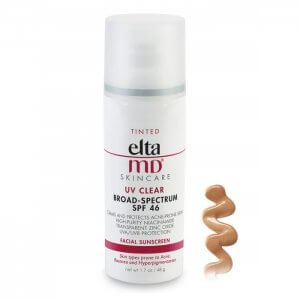Skin of color requires a little extra TLC. From hyperpigmentation to an increased risk for more advanced skin cancer, your skin deserves a specific and personalized care approach to keep it healthy and looking great. At U.S. Dermatology Partners of Sugar Land, Dr. Miranda Uzoma Ewelukwa enjoys partnering with patients of color to help them get healthier skin. According to Dr. Uzoma Ewelukwa, “Many people of color struggle to find good products for their skin, or they get bad advice from people who aren’t as experienced in treating skin of color. I’ve been there myself, and it makes me passionate about helping men and women of color keep their skin healthy and beautiful.” In this blog, Dr. Uzoma Ewelukwa walks through the top five skincare tips for skin of color.
Related: How to Build a Skincare Routine
1 – Develop the Right Daily Skincare Routine
Every person’s skin is unique, and when you work with a dermatologist, you can get product and treatment recommendations specific to your individual needs.
Some basic care tips for skin of color include:
- Clean gently – harsh chemicals and abrasive agents can irritate the skin, leading to inflammation and discoloration. They can also strip moisture from the skin, leading to an ashy appearance. Use mild cleansers formulated for dry skin or specifically for skin of color.
- Moisturize – you should apply a thick, cream moisturizer at least once a day. Apply moisturizer immediately after showering to lock in hydration.
- Take care during hair removal – skin of color is prone to irritation from shaving. You should always take care when shaving and choosing hair removal products. Shave after you shower when your pores are open to minimize risk for irritation and ingrown hairs. Use a thick, moisturizing shaving cream, and don’t worry about those pricey multi-blade razors. A quality, single-blade razor can remove even the coarsest hair, and it’s less likely to pull and snag the hair, which leads to irritation. If you prefer to wax hair, we recommend working with professionals for the best results.
2 – Wear Sunscreen
According to Dr. Uzoma Ewelukwa, “There is a pervasive misconception that darker skin types do not need sunscreen protection. This is false as sun damage does not discriminate and can affect ALL skin types! Sun damage can negatively impact skin of color, causing hyperpigmentation, rosacea, melasma, cutaneous lupus, photoaging/wrinkles, skin cancer, and many other common skin conditions. It is imperative that a broad-spectrum SPF 30+ sunscreen regimen is implemented in all skin of color patients to protect against harmful UVA and UVB rays.”
Sunscreen is especially important if individuals plan to be outdoors for long periods, but even minimal daily sun exposure can lead to cumulative damage without appropriate daily sun protection. For this reason, it’s recommended that everyone applies a broad-spectrum sunscreen each day to areas of the body that will be exposed to sunlight. Dr. Uzoma Ewelukwa says, “I recommend sunscreens with physical blockers (zinc oxide and/or titanium dioxide) as they tend to be gentler formulas and are safe for all skin types and even for use on infants. Iron oxide is a plus as it also blocks visible light which has been linked to flares in hyperpigmentation disorders, such as melasma.”
Some of Dr. Uzoma Ewelukwa’s favorite sunscreen brands for skin of color include:
-
EltaMD UV Clear Tinted SPF 46 (contains iron oxide and zinc oxide) – great for acne and rosacea-prone skin and skin susceptible to hyperpigmentation. Purchase this product on dermskincare.com
- Isdin Eryfotona Actinica SPF 50+ (contains zinc oxide) – water-resistant, so it’s great for the summer; includes DNA repairsomes that help to repair prior sun damage.
- La Roche-Posay Antihelios Tinted Mineral Ultra-Light Fluid Broad Spectrum SPF 50 (contains titanium dioxide and iron oxide) – glides on light with no cast left after rubbing; includes CellOx for antioxidant effects; great for sensitive skin, acneic skin, and skin susceptible to hyperpigmentation.
3 – Perform Skin Cancer Self-Exams Regularly
Many of her patients believe that skin cancer does not affect people of color, but this is not the case. Dr. Uzoma Ewelukwa says, “While the risks of skin cancer are much lower in skin of color patients compared with Caucasian patients, it is still imperative that skin of color patients see a dermatologist for regular skin checks, especially since Melanoma in this group can occur in areas that the sun doesn’t access, usually on the palms of hands and soles of feet. This subtype of melanoma is known as acral lentiginous melanoma, and due to the location of this cancer, patients tend to present when it is advanced. Sunscreen will not help with this form of skin cancer, but it does effectively protect against other forms of skin cancer, such as basal cell and squamous cell carcinoma, as well as preventing sunburn, hyperpigmentation, and photoaging.”
In order for patients of color to catch signs of skin cancer as early as possible, we recommend performing regular skin cancer self-exams. You can find a good skin cancer self-exam guide on the U.S. Dermatology Partners website. This guide focuses on moles, but according to Dr. Uzoma Ewelukwa, “Skin of color patients should be aware of any growths on their body and seek medical attention for any lesion that is growing quickly, bleeding, painful, changing colors, or is otherwise concerning.”
4 – Take Steps to Prevent Hyperpigmentation in Skin of Color
Hyperpigmentation occurs when skin overproduces melanin, which is the substance that gives skin its color. These darker spots are most common on the face, but they can appear anywhere on the body. There are numerous reasons the skin might be triggered to produce excess melanin, and by avoiding or treating these concerns right away, you may be able to prevent hyperpigmentation. Wearing sunscreen is one of the easiest ways to prevent dark spots as sun damage is the leading cause of hyperpigmentation in skin of color patients. However, hyperpigmentation can also occur due to inflammation or trauma to the skin.
Some common causes of hyperpigmentation include:
- Shaving and waxing
- Using harsh exfoliants
- Untreated skin conditions like acne, eczema, or psoriasis
- Allergic response to skincare products or cosmetics
- Bug bites
- Cuts, burns, or scratches
- Surgical incisions
To prevent hyperpigmentation, you should use the right products for your skin, treat chronic skin conditions and wounds right away, and avoid irritants and allergens that could trigger melanin production. Your dermatologist can help you pinpoint the underlying causes of hyperpigmentation and develop a plan to keep your skin tone even and diminish the visibility of dark spots after they occur.
5 – Visit Your Dermatologist for Regular Exams
If you’re prone to hyperpigmentation, you should visit a dermatologist regularly. We can help you find the best skincare products and cosmetics, address any dark spots quickly, and just generally partner with you to keep your skin healthy. If you’re in the Sugar Land area, Dr. Uzoma Ewelukwa and her team would love to hear from you. If you’re not in the Sugar Land area, you can use the convenient U.S. Dermatology Partners appointment request form to get in touch with an office location near you.
Find a location near me
or



